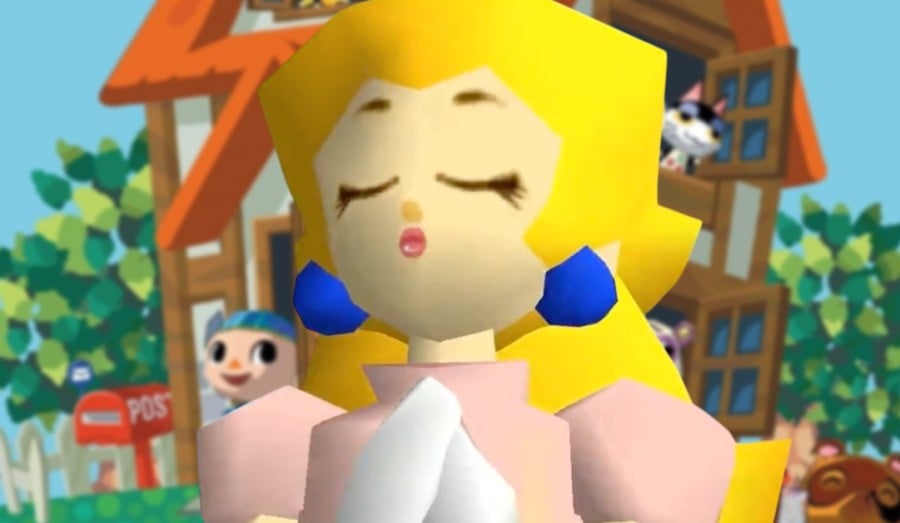
By her own admission, Leslie Swan isn’t a very good self-promoter, but she needn’t worry as her credits do a great job of getting across her credentials for her.
Over her 28 years at Nintendo, she has been credited on dozens of games as a localization manager, working on pretty much all the mainline Zelda titles from Majora’s Mask to Majora’s Mask 3D, in addition to games like Animal Crossing, and WarioWare.
Joining Nintendo of America in 1988, at a time when the company was still mostly a marketing and distribution outpost for its Japanese owners, she started out doing odd editing jobs here and there, before eventually joining Nintendo Power in the role of a writer/editor.
It was here that she would be responsible for a range of responsibilities, from organising some of the magazines’ crazy competitions to writing about the latest games, and working on the Super Mario Adventures comic. However, none of this is arguably what she is most remembered for.
Instead, most people online typically know her for role as Princess Peach in Super Mario 64, a job that she states came about pretty much by accident, due to being the only English-speaking woman in Nintendo EAD at the time.
We recently reached out to Swan to hear more about her remarkable career at Nintendo, from how she joined the company initially to how Princess Peach ended up helping Animal Crossing make the difficult journey to the West. You can read our conversation below (slightly edited and condensed for clarity and length):
Time Extension: First off, I’d love to know, how did you originally get the job at Nintendo?
Swan: I had actually been an English teacher in a high school in a small town. I had just got married, and my husband and I had moved to the Seattle area after the school year had started, so I needed some kind of a holdover job until the hiring for the following year started.
While I was applying for jobs, I saw an ad for Nintendo and I thought I’ll go check that out because I told my husband I’d try anything. So I went in, they offered me a job in consumer service, and the first week I was there, they had me and a few other people that were hired at around the same time sitting at a table playing Zelda for roughly a week because they just wanted to know that we could play a video game.
That was my indoctrination, or my first entry into Nintendo.
Time Extension: Following that, you later ended up going to work on Nintendo Power magazine. How did that come about? And what did your role on the magazine end up being?
Swan: When I started at Nintendo, Nintendo Power wasn’t a thing. It didn’t exist yet. But when it did eventually start, the Nintendo Power editor Gail Tilden asked me if I would do some editing and I agreed.
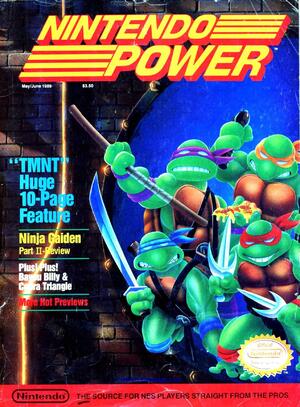
I did that and then after a few months of doing just editing, they offered me a job as a writer/editor for the magazine. So I started pretty early on with Nintendo Power. We had to be playing games all the time and, of course, I got very addicted to it and ended up loving it.
Gail just made working on that magazine so much fun.
I also did a lot of the crazy trips and prizes. The first few of those I wasn’t responsible for, but later on that became one of my other responsibilities. So I was not only meeting deadlines and everything else, but also putting together a contest every month with a game that was about to come out or something else that was fun. I remember I would go home from work some days and tell my husband what I had been up to and he would just laugh and say, ‘You’re getting paid for this?’
Time Extension: Other than the competitions, it also seems you were involved with the Super Mario Bros. comic, which was published in Nintendo Power. Could you tell us a little about what that was like to work on?
Swan: Yeah, so I did the English writing on that, and looking back now, most people won’t believe the way we did things back then.
We didn’t have email at that point. So we couldn’t be emailing back and forth, sending images and that. So the way we worked was that we would get a really rough sketch faxed over with unfinished Japanese in bubbles that were really hard to read, and we had a bilingual administrative assistant on our team and she would sit down with me and say, ‘This is what I think is happening in the scene’. They were really rough sketches, though, so a lot of the time you couldn’t tell who was in the frame, so I would have to write what I thought would be the translation.
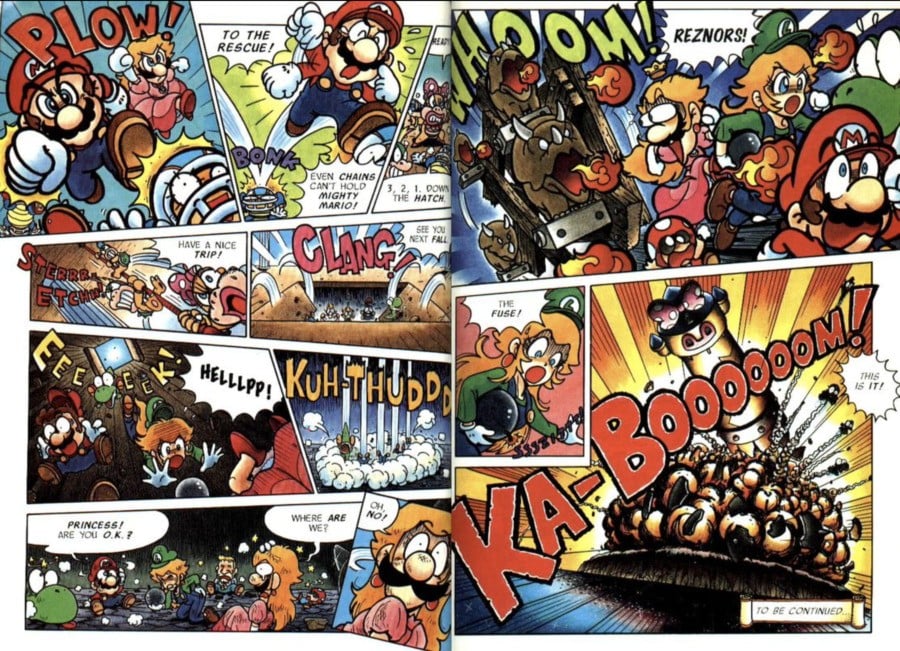
So we would send that back, and that would also be rough, and then they would fax over an updated version where they would check over what we had sent and would add in sound effects.
The sound effects were always the hardest thing because our admin Machiko [Oehler] would say, ‘Well, this is the sound of metal hitting wood. What would that sound like?’ And so I would have to come up with something. Or ‘Here’s a lightweight character running down a hall with linoleum floors. What does that sound like?’ So pittapatta pittapatta. I remember this one scene, Machiko was like, ‘This is the sound of a cloud in the sky’, which turned out to be the sound of a cloud suddenly appearing in the sky: poof!
Time Extension: Looking back, it would be interesting to hear, what do you think the value of having something like Nintendo Power was at the time for a company like Nintendo?
Swan: It was really a different time. It was pre-internet, so nobody was getting game information online. There were no other publications. And so when we started, kids really considered it the place to go get information. EGM and other publications came later obviously, and I got to know a lot of people who worked on those, but in the beginning we were the only place to go.
And, you know, it’s really funny to me, when I was hiring writers and translators later on for localization, so many of them had started out reading Nintendo Power; it was like a religion to them. They would say, ‘I would wait every month to get my magazine in the mail’ and we also used to get a lot of mail saying, ‘My friend down the block got his a week earlier than I did.’ So it was a big deal when people’s Nintendo Power came, because we could answer a lot of the questions, and provide tips and tricks, because we were working directly with the developers.
Time Extension: Later on, you obviously went on to work in localization at Nintendo. Do you remember when you became involved in the game side of things? It says online you may have been involved with A Link To The Past. Is that correct?
Swan: I did some editing on that. But it was before I moved to localization. I had expertise in editing and so I got tapped to do a lot of different projects like that, but Dan Owsen was the primary writer on that.
Later, though, when we were launching the Nintendo 64, we were doing a player’s guide for Super Mario 64 (Nintendo Power also produced the player’s guides) and I went in and told Gail, ‘This is a really, really special game. We need to get a professional writing team on it’. Because we really didn’t have a real localization team at Nintendo at that time.
A few days later, I came in and she said to me, ‘Do you have a passport?’ and ‘They want you to go to Kyoto and do the writing on this game.’ I was like, ‘Okay, I wasn’t exactly suggesting myself for that role’, but she just said, ‘We’ll free you up!’ So that was my first real localization experience, and doing it in Kyoto was a really special experience.
Time Extension: Do you have any memories of any of the decisions that you had to make while working on that game?
Swan: Well, one thing that I thought was really funny was, in the early days, there wasn’t a lot of communication between the dev teams and what we were doing from a marketing standpoint in the United States.
So on Super Mario Bros. they had outsourced the production of the manual to an ad agency. And the ad agency just kind of created names for things. And so they’re the ones who came up with Princess Toadstool as the name for Peach.
So when I went over and I was working on the localization, I would sit with Mr. Miyamoto and a translator and they would be going over the changes I had made and I would explain why I was making the changes, and one day, Mr. Miyamoto just said, ‘Is Peach a bad name?’ And I had to tell him, ‘No, but you know she is called Princess Toadstool in the US’. I remember he said, ‘Well, I really like Peach as her name’. So I came up with the idea to say, ‘Why don’t we call her Princess Peach Toadstool?’ Then we could refer to her informally as Peach.
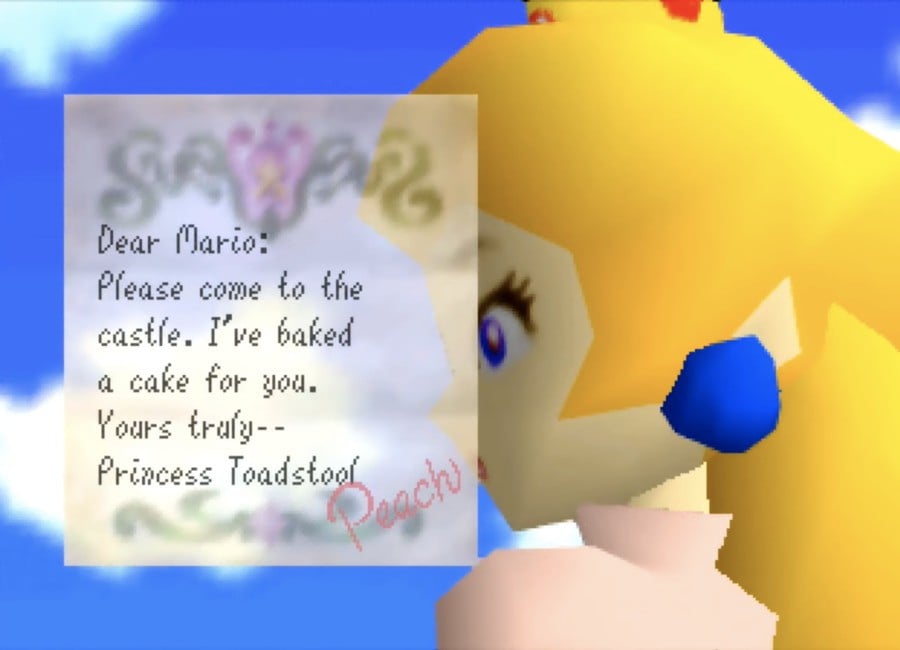
So, at the very beginning of the game, there’s that message from Princess Peach to Mario saying ‘Dear Mario, Please come to the castle. I baked a cake for you.’ She initially signs it formally as Princess Toadstool, but then she handwrites Peach over the top of it to be less formal.
Time Extension: As well as helping on the localization for Super Mario 64, you also did the voice of Princess Peach in the game. How did you end up getting involved in voice acting?
Swan: Nintendo was just such a special place to work at in those days. So you would just step in where you were asked to, and I was pretty much ready to raise my hand for anything.
At the time, I was the only English-speaking person in the development area within EAD, and they had already finished the game. They would always finish the Japanese version of the game first and then they would start on the North American version, and after we were done, they would do the European version too. And, in the process of doing the adaptation for the North American market, they kind of compressed everything down and had some memory left, so they said, ‘Well, you know, we would really like to use this to put some voice in the game’. And so they had Charles Martinet record that first thing, ‘It’s a-me, Mario’, in the opening screen, and then they asked me, ‘Can you voice Peach?’ So they took me down to the studio, they put me in the booth, and had me do some samples.

The first thing was reading that message at the beginning of the game. They had me read it in different ways, and then this translator there I was working with came on and said, ‘Can you sound sweeter?’ And I just said, ‘I’m not a sweet-sounding person, but I can try. It’ll be a stretch.’ And so that’s how that came about.
But it was just really fun because we just tried a lot of different things, and that team was such a fun group to work with. What was also great was the next day when I came in, they had worked into the night to implement the voice over. So when I came in the next morning, they all gathered around where I was working, and they all had these big smiles on their faces and played the audio back in the game. That was pretty cool.
Time Extension: A few years after Mario 64, you moved over to establish a proper localization team within Nintendo at the turn of the millennium. What was it like moving from Nintendo Power magazine to this new role?
Swan: I was really passionate about what we were going to do with the localization team, but I was also perfectly happy working on the magazine. So when they asked me to move over and start the localization team, I said, ‘Okay, here’s the deal. I will move over and start this new team, but only if you will let me set it up the way I want to’, and that was having really proficient translators working together with really good creative writers.
So what I did was I convinced them to double the the number of people involved by saying, ‘In the long run, it’s going to cut the localization time in half because the translator can be translating, but you can also have the creative writer in there working right behind them.’
I think that is what made the difference in the quality of our localization. So I would put the teams together and I would have them actually sit beside each other. And if the creative writer came along and said, ‘What does this mean?’, the translator could answer them straight away. That was something that became really apparent to me while working on Pokémon Gold & Silver, because I didn’t have the translator on hand and I would have to go find somebody and say, ‘I’m supposed to edit this, but I have no idea what it means.’
Time Extension: Speaking of Pokémon, the first credit that I found for you that was listed under localization management was for the N64 title Hey You, Pikachu!, which launched in the US in November 2000. Do you have any memories of working on that game?
Swan: So Pokémon launched when I was still working on the magazine, and actually, Gail Tilden, who I was saying was the managing editor of Nintendo Power, she got tapped to go over and work in product development before there really was a localization team to help launch Pokemon in the United States, because it was not a done deal.
It took some persuading to get people to really think it was going to take off in the United States. Gail really worked hard to make it happen.
So I was around for all of the launch of that stuff, and we were doing coverage in the magazine, but I didn’t work on Red or Blue. As for the game Hey You, Pikachu!, how that originally came about was I was over in Japan meeting with the dev team in Kyoto and they said, ‘The Pokémon team in Tokyo wonders if you could go from here to Tokyo to meet with them about this project.’ I was traveling with Bill Trinen at the time, who was the main translator on our team at that point, and Bill and I ended up going to Tokyo and met with the team.
I had moved to localization in January of 2000, and so that was one of the first projects that we worked on, and it was quite a challenge. That’s because the voice recognition wasn’t very advanced at that point. And since that game depended on voice recognition, we had to go through the phonetic alphabets for every character and every request and command. We actually worked with a dialect specialist from the University of Washington to try to cover as many dialects as we could for our market. And so we had to do phonetic spellings for all of the different dialects. And even then, the voice recognition was a little difficult.
Time Extension: Besides Hey You, Pikachu!, can you remember any of the other projects you worked on at Nintendo that proved particularly difficult to localise? Or maybe took more of a heavy lift on behalf of the localization team?
Swan: I have one excellent example of that — Animal Crossing.
The guy who was heading up that project was Mr. Tezuka. And he was such a delightful person to work with. I think originally he had come over to visit for E3, and he had stopped by the offices in Redmond and asked if he could have a meeting. So we had this nice deck and we were sitting out in the Fall, just kind of shooting the breeze, and then he said to me, ‘I’ve got to talk to you about this game.’
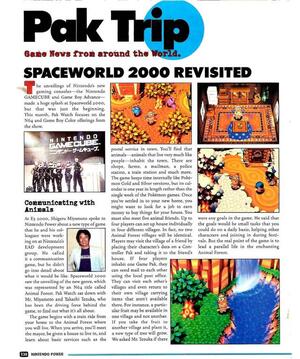
At the time, we knew of Animal Forest, but we hadn’t really dinked around with it — we usually would get the Japanese versions of games and play through them. But we hadn’t really messed around with that one very much. So, anyway, he basically said to me, ‘We’d like to have you localize it’ and I said, ‘Sure’. But then he said, ‘No, Leslie, I’m not sure you understand, it’s going to be difficult’. And I kept having to assure him that we would make it happen.
Then like a month or two later, I was in a meeting with Mr. Iwata and some other heads of the development group, and we were just kind of going around saying, ‘Here’s what we’re going to be working on’, and I just said, ‘Well, Mr. Tezuka is asking us to work on Animal Forest’ and he just burst out in laughter. He just laughed and said, ‘I don’t know how you’re going to do this.’ And it’s true, just everything in that game was so specific to Japan.
We had to go in and rename every character, every character’s catchphrases, and also the events. So what we would do is go through the list of events they sent over and say, ‘That event’s not going to work at all. We need to find something else that we can do during that month so that month wouldn’t be just empty’. So we wanted whatever it was to be something that would be useful in as many areas as possible so we would do things like call it “Fireworks Day” or something so other cultures, not just the US, would be able to use it without it being tied to Independence Day.
Then there were also some items that didn’t make sense at all. They would have so much charm in the Japanese version, but they wouldn’t have provided the same kind of charm for Western audiences. I can’t tell you the number of hours we spent on that game, all hands on deck. We were so lucky at that point that we didn’t have other big projects, as we pretty much had the entire staff dedicated to that game.
Everybody would get together in a room and we would say, ‘Okay, today we’re going to rename all the furniture in this set’, or ‘Today we’re going to work on names for these characters and their catchphrases’. Then, after this, we would submit all this stuff to our legal department who had to clear everything because our thought from the beginning was if this is big, then we’re going to want to make merchandise.
It must have been at least six months or maybe a year for us to clear the name Animal Crossing. I remember we had so many other names that we were in love with and then we would be crushed when they would be rejected. My favourite was “Animal Acres”, because the grids of the town lent themselves to being called acres. But again, that didn’t clear.
Time Extension: Can you remember any other suggestions?
Swan: Oh, that was such a frustrating point in the project, I’ve probably pushed them all out of mind. We did hundreds.
We really wanted to maintain “Animal” in the name. And we did try to keep “Forest” in the name too, but legal told us, ‘No, that’s not going to happen.’
Sometimes I would just go to them and say, ‘Okay, I want you to walk me through why this failed or why this failed, so we don’t waste any more time going this direction or that direction.’ And that was just so that I understood why something wasn’t working so we could move in a different direction. But yeah, the naming of products was a really challenging part of the job.
Animal Crossing was probably the most difficult. But, you know, going back to Zelda and Mario, those game names always had to evolve and get bigger.
So it was Mario Bros, Super Mario Bros, Super Mario Bros 2, Super Mario Bros 3. And then we started going off into World and Super Mario Universe, which became Super Mario Galaxy. So those names all kind of had to have some rhyme or reason. They weren’t just tacked on. The Zelda names were very much the same way too. Whatever the subtitles were, it always had to represent something new, like a new item in the game that was going to be really significant, like Majora’s Mask.
Time Extension: Besides Peach, you also voiced a couple of characters in WarioWare. Do you remember how you were tapped for that? Was that the same situation as Mario 64? You were just in the right place at the right time?
Swan: WarioWare, I believe, was its own special example because that team really prided itself on sticking to budgets and doing as much as they could on tight budgets. So they didn’t want to pay actors. So they would just say, ‘Well, who can do this?’ and ‘Who can do that?’ So I did Mona and I did 9-Volt, but for whatever reason I wasn’t credited with 9-Volt. That doesn’t matter though.
A lot of the time we would actually go down to one of the local studios and just try out different voices, and, depending on who was in the studio that day, they just happened to be the ones to do those voices. I ended up doing voice for a lot of games that I was never credited for.
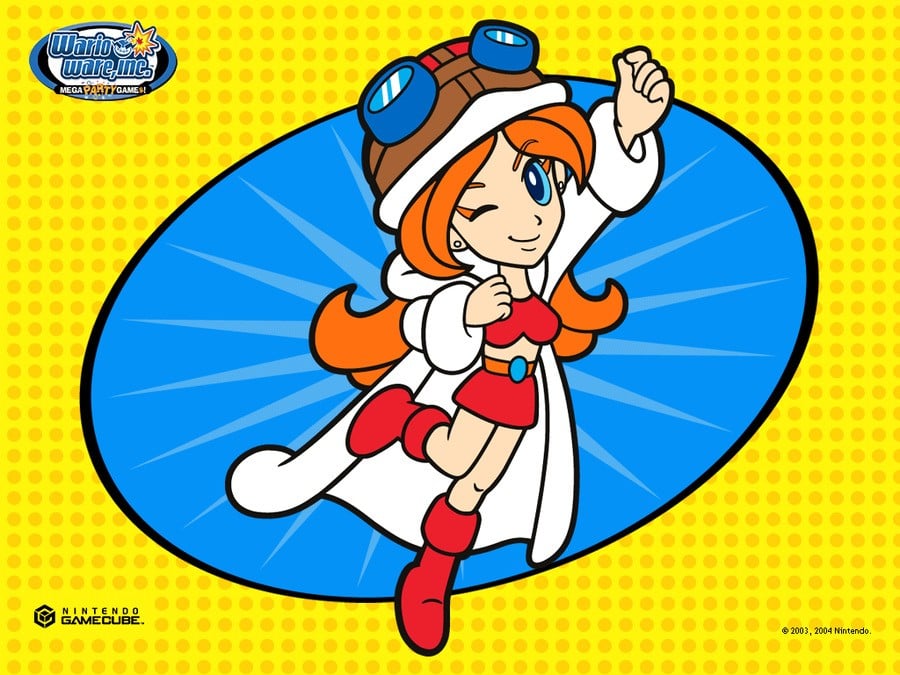
Sometimes it was just sound effects. But there were other times that team would say, ‘We don’t want to pay for a studio.’ And so we had what we called the “Phone Booth” at Nintendo of America and it was a small room that we would try to fit as many people into as possible. They were not sophisticated recordings, but that’s where we would do stuff like crowd noises.
One of the funny things is I’ve often seen people argue a lot about video game voices online: who is the better actor for this voice or that voice? We’ve had several actresses for Peach, but, even now, if you look at some of the websites where people debate who the best Peach voice was, several people still say I was. In fact, I saw this one person say, ‘It was so awful that Nintendo fired her’ and I remember sitting there thinking, ‘Wait, I fired myself.’
Time Extension: I did find a Reddit post that was talking about all the different Peach actors. It said something like ‘All the Peach actors have done so many interviews about their performances and what it’s like being a voice actor and stuff, but I’ve never seen an interview with Leslie Swan’. I guess that was because voice acting was never your main goal. It’s just something that happened accidentally.
Swan: Yeah, it never would have occurred to me to even have a voice credit for games like WarioWare. My thing was localizing games, not voice acting. And, honestly, there was very much a period there where the market was mostly boys.
I’ve never been a good self-promoter, I always wanted to get the younger guys out there talking about the games they were working on, because I thought it was just a better fit for the audience. And I just didn’t think at the time that a middle aged woman being out there talking about being Peach was necessarily good for the product.
Time Extension: Yeah, thankfully video games have moved on from that. Now a lot of people love hearing about the fact that gaming is for everyone. I think the pandemic was very interesting for that, because you had so many stories about people of all ages, genders, and nationalities connecting over games like Animal Crossing New Horizons. It became the meeting place for groups of people, including families, who obviously couldn’t see each other.
Swan: That was always kind of one of our goals from the beginning: ‘How do we make players engage with each other instead of having this be a solitary experience?’ So when Nintendo was first getting into multiplayer games, everybody was really excited about that.
And you’re right, more strong female characters did start appearing in games, but it was pretty frustrating in the beginning. I would be kind of the lone voice going, ‘Yes, this is a strong character, but why does she have to have giant boobs, a tiny waist, and look like that? Why can’t she just be athletic?’ It took a while to get through that.
Time Extension: Obviously, over the years, you went on to work on a long list of games at Nintendo, but ultimately decided to leave the company in 2016. I’m wondering, what motivated you to finally make that decision?
Swan: It was a time when there was a lot of change happening at Nintendo and we were trying to bring new people in and develop them. They were also launching their digital business and a new fun club, My Nintendo. And, because I’d worked on the games and the club aspect of Nintendo Power, they asked me if I would help with that.
So I said, ‘Yeah, I’m up for a new challenge. That’s fine. Everything’s rolling right along in localization.’ And so I did that and stayed through launch. And once that product launched, I was ready to retire.
I have to say, I was so lucky to be able to work at Nintendo. It was a lot of work. It was a lot of stress. But one of the things that kept me there as long as I stayed was I just felt like I was learning something new with every single product we worked on. There was new technology and there was always something new to be learned, and the teams I worked with were just so energetic. The whole of the company was just oozing energy. It felt like such a family.
Source link


